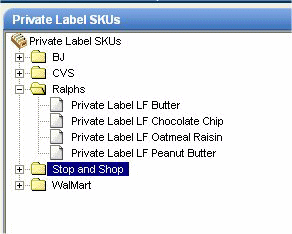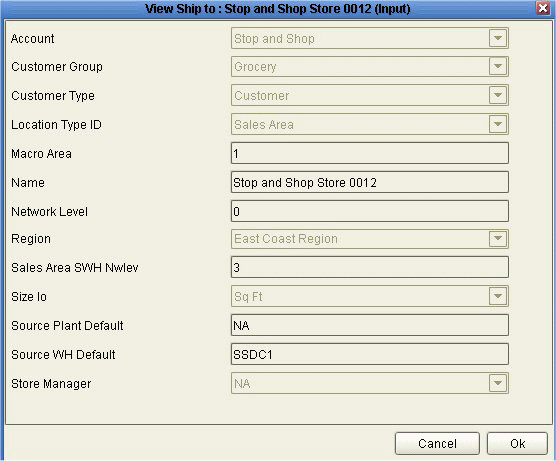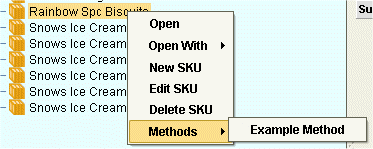Using a Members Browser Content Pane
This chapter covers the following topics:
- Introduction to the Members Browser
- Launching a Filtered Worksheet
- Viewing the Attributes of a Member
- About Creating, Editing, and Deleting Members
- Creating a Member
- Modifying a Member
- Deleting a Member
- Using Other Right-Click Menu Options
Introduction to the Members Browser
A content pane may include the Members Browser, which looks like the following:

You use this content pane for the following general purposes:
-
To launch worksheets
-
To view the attributes of a member.
-
To create, edit, and delete members.
-
To perform additional operations on members, as defined within your implementation.
These options are available on the right-click menu.
Launching a Filtered Worksheet
Depending on how your system has been configured, you may be able to open a worksheet from within a Members Browser; the worksheet is filtered to show only data relevant to the member from which you started.
The specific options are usually different for each aggregation level in your system.
To open a member in a worksheet
Do one of the following in a Members Browser:
-
Right-click the member and then select Open. In this case, you are using the default worksheet associated with this level.
-
Right-click the member and then select Open With and then select a worksheet.
The worksheet appears in a new window.
Note: Depending on how this worksheet is defined, it is filtered in one of two ways:
-
Filtered by member, that is, filtered to show the member from which it was launched, aggregating across all combinations. In this case, the name of the worksheet is preceded by the name of the member by which you are filtering it.
-
Filtered by combination, that is filtered to show the specific combination from which it was launched. In this case, the name of the worksheet is preceded by the word “Filtered”.
Viewing the Attributes of a Member
To view the attributes of a member
-
In a Members Browser, do the following:
-
Right-click a member and click View (for example, View Ship to).
Oracle Demantra displays a dialog box like the following:

The attributes shown in red are required. These include the Name attribute and all immediate parents of this member.
About Creating, Editing, and Deleting Members
For any level, most or all members are defined by data that is imported into Oracle Demantra. For example, the brands in your system are defined by the imported sales records, which include information about the brand of each item that is sold. The imported data specifies the attributes of the existing members.
Depending on your authorization, you might be able to edit or delete existing members and add new members of a given level. Permission is set separately for each level and potentially for each user.
If you make any of these changes, you should be aware of how Oracle Demantra interacts with your corporate systems. Oracle Demantra periodically imports data about sales, items, and locations from your other systems. Each time data is imported into your system, the changes you have made to the levels are overwritten, depending on the kind of change.
-
You should edit or delete existing members only if you are expecting the same change to occur in the imported data, and you need to see the change right away within Oracle Demantra for some reason.
-
If you add members, they will be kept when data is imported.
Creating a Member
-
Do one of the following within a Members Browser:
-
Right-click an existing object and then select New (for example, New SKU).
-
Right-click the blank area and then select the appropriate option.
Demantra displays a window where you specify the name of the new member, as well as its parent levels and other attributes.
-
-
For Name, specify a unique name.
-
The rest of the fields prompt you for values of attributes associated with this level; the fields shown in red are required. The specific attributes you see depend upon your configuration.
-
Click Create.
Note: You cannot see the new member in the Members Browser, because the Members Browser displays only item-location combinations that exist and that have sales.
Modifying a Member
You can modify a member by changing its name, the parent members to which it belongs, and any visible attributes.
To modify a member
-
In a Members Browser, do the following:
-
Right-click a member and click Edit (for example, Edit SKU). Then make changes as needed; see Creating a Member for details.
-
Click Finish.
See also About Creating, Editing, and Deleting Members
Deleting a Member
-
In a Members Browser, right-click a member and click Delete (for example, Delete SKU).
-
Oracle Demantra prompts you to confirm the action. Click Yes or No.
See also About Creating, Editing, and Deleting Members
Using Other Right-Click Menu Options
Depending on your implementation, the right-click menu may include a Methods submenu that includes additional options created by your implementors:

When you click one of these options, Oracle Demantra displays a dialog box like the following:

Select the Save parameters check box if you want to save the attribute changes to the database when the method is run.
For information on any such menu items, please contact your implementors or your designated Oracle Demantra system administrator.